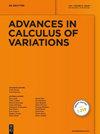求助PDF
{"title":"具有低阶余项的尖锐Sobolev不等式的一个扭曲","authors":"Emmanuel Hebey","doi":"10.1515/acv-2022-0046","DOIUrl":null,"url":null,"abstract":"Abstract Let <m:math xmlns:m=\"http://www.w3.org/1998/Math/MathML\"> <m:mrow> <m:mo stretchy=\"false\">(</m:mo> <m:mi>M</m:mi> <m:mo>,</m:mo> <m:mi>g</m:mi> <m:mo stretchy=\"false\">)</m:mo> </m:mrow> </m:math> {(M,g)} be a smooth compact Riemannian manifold of dimension <m:math xmlns:m=\"http://www.w3.org/1998/Math/MathML\"> <m:mrow> <m:mi>n</m:mi> <m:mo>≥</m:mo> <m:mn>3</m:mn> </m:mrow> </m:math> {n\\geq 3} . Let also A be a smooth symmetrical positive <m:math xmlns:m=\"http://www.w3.org/1998/Math/MathML\"> <m:mrow> <m:mo stretchy=\"false\">(</m:mo> <m:mn>0</m:mn> <m:mo>,</m:mo> <m:mn>2</m:mn> <m:mo stretchy=\"false\">)</m:mo> </m:mrow> </m:math> {(0,2)} -tensor field in M . By the Sobolev embedding theorem, we can write that there exist <m:math xmlns:m=\"http://www.w3.org/1998/Math/MathML\"> <m:mrow> <m:mrow> <m:mi>K</m:mi> <m:mo>,</m:mo> <m:mi>B</m:mi> </m:mrow> <m:mo>></m:mo> <m:mn>0</m:mn> </m:mrow> </m:math> {K,B>0} such that for any <m:math xmlns:m=\"http://www.w3.org/1998/Math/MathML\"> <m:mrow> <m:mi>u</m:mi> <m:mo>∈</m:mo> <m:mrow> <m:msup> <m:mi>H</m:mi> <m:mn>1</m:mn> </m:msup> <m:mo></m:mo> <m:mrow> <m:mo stretchy=\"false\">(</m:mo> <m:mi>M</m:mi> <m:mo stretchy=\"false\">)</m:mo> </m:mrow> </m:mrow> </m:mrow> </m:math> {u\\in H^{1}(M)} , (0.1) <m:math xmlns:m=\"http://www.w3.org/1998/Math/MathML\"> <m:mrow> <m:msubsup> <m:mrow> <m:mo>∥</m:mo> <m:mi>u</m:mi> <m:mo>∥</m:mo> </m:mrow> <m:msup> <m:mi>L</m:mi> <m:msup> <m:mn>2</m:mn> <m:mo>⋆</m:mo> </m:msup> </m:msup> <m:mn>2</m:mn> </m:msubsup> <m:mo>≤</m:mo> <m:mrow> <m:mrow> <m:mi>K</m:mi> <m:mo></m:mo> <m:msubsup> <m:mrow> <m:mo>∥</m:mo> <m:mrow> <m:msub> <m:mo>∇</m:mo> <m:mi>A</m:mi> </m:msub> <m:mo></m:mo> <m:mi>u</m:mi> </m:mrow> <m:mo>∥</m:mo> </m:mrow> <m:msup> <m:mi>L</m:mi> <m:mn>2</m:mn> </m:msup> <m:mn>2</m:mn> </m:msubsup> </m:mrow> <m:mo>+</m:mo> <m:mrow> <m:mi>B</m:mi> <m:mo></m:mo> <m:msubsup> <m:mrow> <m:mo>∥</m:mo> <m:mi>u</m:mi> <m:mo>∥</m:mo> </m:mrow> <m:msup> <m:mi>L</m:mi> <m:mn>1</m:mn> </m:msup> <m:mn>2</m:mn> </m:msubsup> </m:mrow> </m:mrow> </m:mrow> </m:math> \\|u\\|_{L^{2^{\\star}}}^{2}\\leq K\\|\\nabla_{A}u\\|_{L^{2}}^{2}+B\\|u\\|_{L^{1}}^{2} where <m:math xmlns:m=\"http://www.w3.org/1998/Math/MathML\"> <m:mrow> <m:msup> <m:mi>H</m:mi> <m:mn>1</m:mn> </m:msup> <m:mo></m:mo> <m:mrow> <m:mo stretchy=\"false\">(</m:mo> <m:mi>M</m:mi> <m:mo stretchy=\"false\">)</m:mo> </m:mrow> </m:mrow> </m:math> {H^{1}(M)} is the standard Sobolev space of functions in <m:math xmlns:m=\"http://www.w3.org/1998/Math/MathML\"> <m:msup> <m:mi>L</m:mi> <m:mn>2</m:mn> </m:msup> </m:math> {L^{2}} with one derivative in <m:math xmlns:m=\"http://www.w3.org/1998/Math/MathML\"> <m:msup> <m:mi>L</m:mi> <m:mn>2</m:mn> </m:msup> </m:math> {L^{2}} , <m:math xmlns:m=\"http://www.w3.org/1998/Math/MathML\"> <m:mrow> <m:msup> <m:mrow> <m:mo stretchy=\"false\">|</m:mo> <m:mrow> <m:msub> <m:mo>∇</m:mo> <m:mi>A</m:mi> </m:msub> <m:mo></m:mo> <m:mi>u</m:mi> </m:mrow> <m:mo stretchy=\"false\">|</m:mo> </m:mrow> <m:mn>2</m:mn> </m:msup> <m:mo>=</m:mo> <m:mrow> <m:mi>A</m:mi> <m:mo></m:mo> <m:mrow> <m:mo stretchy=\"false\">(</m:mo> <m:mrow> <m:mo>∇</m:mo> <m:mo></m:mo> <m:mi>u</m:mi> </m:mrow> <m:mo>,</m:mo> <m:mrow> <m:mo>∇</m:mo> <m:mo></m:mo> <m:mi>u</m:mi> </m:mrow> <m:mo stretchy=\"false\">)</m:mo> </m:mrow> </m:mrow> </m:mrow> </m:math> {|\\nabla_{A}u|^{2}=A(\\nabla u,\\nabla u)} and <m:math xmlns:m=\"http://www.w3.org/1998/Math/MathML\"> <m:msup> <m:mn>2</m:mn> <m:mo>⋆</m:mo> </m:msup> </m:math> {2^{\\star}} is the critical Sobolev exponent for <m:math xmlns:m=\"http://www.w3.org/1998/Math/MathML\"> <m:msup> <m:mi>H</m:mi> <m:mn>1</m:mn> </m:msup> </m:math> {H^{1}} . We compute in this paper the value of the best possible K in (0.1) and investigate the validity of the corresponding sharp inequality.","PeriodicalId":49276,"journal":{"name":"Advances in Calculus of Variations","volume":"102 1","pages":"0"},"PeriodicalIF":1.4000,"publicationDate":"2023-01-27","publicationTypes":"Journal Article","fieldsOfStudy":null,"isOpenAccess":false,"openAccessPdf":"","citationCount":"0","resultStr":"{\"title\":\"A twist in sharp Sobolev inequalities with lower order remainder terms\",\"authors\":\"Emmanuel Hebey\",\"doi\":\"10.1515/acv-2022-0046\",\"DOIUrl\":null,\"url\":null,\"abstract\":\"Abstract Let <m:math xmlns:m=\\\"http://www.w3.org/1998/Math/MathML\\\"> <m:mrow> <m:mo stretchy=\\\"false\\\">(</m:mo> <m:mi>M</m:mi> <m:mo>,</m:mo> <m:mi>g</m:mi> <m:mo stretchy=\\\"false\\\">)</m:mo> </m:mrow> </m:math> {(M,g)} be a smooth compact Riemannian manifold of dimension <m:math xmlns:m=\\\"http://www.w3.org/1998/Math/MathML\\\"> <m:mrow> <m:mi>n</m:mi> <m:mo>≥</m:mo> <m:mn>3</m:mn> </m:mrow> </m:math> {n\\\\geq 3} . Let also A be a smooth symmetrical positive <m:math xmlns:m=\\\"http://www.w3.org/1998/Math/MathML\\\"> <m:mrow> <m:mo stretchy=\\\"false\\\">(</m:mo> <m:mn>0</m:mn> <m:mo>,</m:mo> <m:mn>2</m:mn> <m:mo stretchy=\\\"false\\\">)</m:mo> </m:mrow> </m:math> {(0,2)} -tensor field in M . By the Sobolev embedding theorem, we can write that there exist <m:math xmlns:m=\\\"http://www.w3.org/1998/Math/MathML\\\"> <m:mrow> <m:mrow> <m:mi>K</m:mi> <m:mo>,</m:mo> <m:mi>B</m:mi> </m:mrow> <m:mo>></m:mo> <m:mn>0</m:mn> </m:mrow> </m:math> {K,B>0} such that for any <m:math xmlns:m=\\\"http://www.w3.org/1998/Math/MathML\\\"> <m:mrow> <m:mi>u</m:mi> <m:mo>∈</m:mo> <m:mrow> <m:msup> <m:mi>H</m:mi> <m:mn>1</m:mn> </m:msup> <m:mo></m:mo> <m:mrow> <m:mo stretchy=\\\"false\\\">(</m:mo> <m:mi>M</m:mi> <m:mo stretchy=\\\"false\\\">)</m:mo> </m:mrow> </m:mrow> </m:mrow> </m:math> {u\\\\in H^{1}(M)} , (0.1) <m:math xmlns:m=\\\"http://www.w3.org/1998/Math/MathML\\\"> <m:mrow> <m:msubsup> <m:mrow> <m:mo>∥</m:mo> <m:mi>u</m:mi> <m:mo>∥</m:mo> </m:mrow> <m:msup> <m:mi>L</m:mi> <m:msup> <m:mn>2</m:mn> <m:mo>⋆</m:mo> </m:msup> </m:msup> <m:mn>2</m:mn> </m:msubsup> <m:mo>≤</m:mo> <m:mrow> <m:mrow> <m:mi>K</m:mi> <m:mo></m:mo> <m:msubsup> <m:mrow> <m:mo>∥</m:mo> <m:mrow> <m:msub> <m:mo>∇</m:mo> <m:mi>A</m:mi> </m:msub> <m:mo></m:mo> <m:mi>u</m:mi> </m:mrow> <m:mo>∥</m:mo> </m:mrow> <m:msup> <m:mi>L</m:mi> <m:mn>2</m:mn> </m:msup> <m:mn>2</m:mn> </m:msubsup> </m:mrow> <m:mo>+</m:mo> <m:mrow> <m:mi>B</m:mi> <m:mo></m:mo> <m:msubsup> <m:mrow> <m:mo>∥</m:mo> <m:mi>u</m:mi> <m:mo>∥</m:mo> </m:mrow> <m:msup> <m:mi>L</m:mi> <m:mn>1</m:mn> </m:msup> <m:mn>2</m:mn> </m:msubsup> </m:mrow> </m:mrow> </m:mrow> </m:math> \\\\|u\\\\|_{L^{2^{\\\\star}}}^{2}\\\\leq K\\\\|\\\\nabla_{A}u\\\\|_{L^{2}}^{2}+B\\\\|u\\\\|_{L^{1}}^{2} where <m:math xmlns:m=\\\"http://www.w3.org/1998/Math/MathML\\\"> <m:mrow> <m:msup> <m:mi>H</m:mi> <m:mn>1</m:mn> </m:msup> <m:mo></m:mo> <m:mrow> <m:mo stretchy=\\\"false\\\">(</m:mo> <m:mi>M</m:mi> <m:mo stretchy=\\\"false\\\">)</m:mo> </m:mrow> </m:mrow> </m:math> {H^{1}(M)} is the standard Sobolev space of functions in <m:math xmlns:m=\\\"http://www.w3.org/1998/Math/MathML\\\"> <m:msup> <m:mi>L</m:mi> <m:mn>2</m:mn> </m:msup> </m:math> {L^{2}} with one derivative in <m:math xmlns:m=\\\"http://www.w3.org/1998/Math/MathML\\\"> <m:msup> <m:mi>L</m:mi> <m:mn>2</m:mn> </m:msup> </m:math> {L^{2}} , <m:math xmlns:m=\\\"http://www.w3.org/1998/Math/MathML\\\"> <m:mrow> <m:msup> <m:mrow> <m:mo stretchy=\\\"false\\\">|</m:mo> <m:mrow> <m:msub> <m:mo>∇</m:mo> <m:mi>A</m:mi> </m:msub> <m:mo></m:mo> <m:mi>u</m:mi> </m:mrow> <m:mo stretchy=\\\"false\\\">|</m:mo> </m:mrow> <m:mn>2</m:mn> </m:msup> <m:mo>=</m:mo> <m:mrow> <m:mi>A</m:mi> <m:mo></m:mo> <m:mrow> <m:mo stretchy=\\\"false\\\">(</m:mo> <m:mrow> <m:mo>∇</m:mo> <m:mo></m:mo> <m:mi>u</m:mi> </m:mrow> <m:mo>,</m:mo> <m:mrow> <m:mo>∇</m:mo> <m:mo></m:mo> <m:mi>u</m:mi> </m:mrow> <m:mo stretchy=\\\"false\\\">)</m:mo> </m:mrow> </m:mrow> </m:mrow> </m:math> {|\\\\nabla_{A}u|^{2}=A(\\\\nabla u,\\\\nabla u)} and <m:math xmlns:m=\\\"http://www.w3.org/1998/Math/MathML\\\"> <m:msup> <m:mn>2</m:mn> <m:mo>⋆</m:mo> </m:msup> </m:math> {2^{\\\\star}} is the critical Sobolev exponent for <m:math xmlns:m=\\\"http://www.w3.org/1998/Math/MathML\\\"> <m:msup> <m:mi>H</m:mi> <m:mn>1</m:mn> </m:msup> </m:math> {H^{1}} . We compute in this paper the value of the best possible K in (0.1) and investigate the validity of the corresponding sharp inequality.\",\"PeriodicalId\":49276,\"journal\":{\"name\":\"Advances in Calculus of Variations\",\"volume\":\"102 1\",\"pages\":\"0\"},\"PeriodicalIF\":1.4000,\"publicationDate\":\"2023-01-27\",\"publicationTypes\":\"Journal Article\",\"fieldsOfStudy\":null,\"isOpenAccess\":false,\"openAccessPdf\":\"\",\"citationCount\":\"0\",\"resultStr\":null,\"platform\":\"Semanticscholar\",\"paperid\":null,\"PeriodicalName\":\"Advances in Calculus of Variations\",\"FirstCategoryId\":\"1085\",\"ListUrlMain\":\"https://doi.org/10.1515/acv-2022-0046\",\"RegionNum\":3,\"RegionCategory\":\"数学\",\"ArticlePicture\":[],\"TitleCN\":null,\"AbstractTextCN\":null,\"PMCID\":null,\"EPubDate\":\"\",\"PubModel\":\"\",\"JCR\":\"Q1\",\"JCRName\":\"MATHEMATICS\",\"Score\":null,\"Total\":0}","platform":"Semanticscholar","paperid":null,"PeriodicalName":"Advances in Calculus of Variations","FirstCategoryId":"1085","ListUrlMain":"https://doi.org/10.1515/acv-2022-0046","RegionNum":3,"RegionCategory":"数学","ArticlePicture":[],"TitleCN":null,"AbstractTextCN":null,"PMCID":null,"EPubDate":"","PubModel":"","JCR":"Q1","JCRName":"MATHEMATICS","Score":null,"Total":0}
引用次数: 0
引用
批量引用
A twist in sharp Sobolev inequalities with lower order remainder terms
Abstract Let ( M , g ) {(M,g)} be a smooth compact Riemannian manifold of dimension n ≥ 3 {n\geq 3} . Let also A be a smooth symmetrical positive ( 0 , 2 ) {(0,2)} -tensor field in M . By the Sobolev embedding theorem, we can write that there exist K , B > 0 {K,B>0} such that for any u ∈ H 1 ( M ) {u\in H^{1}(M)} , (0.1) ∥ u ∥ L 2 ⋆ 2 ≤ K ∥ ∇ A u ∥ L 2 2 + B ∥ u ∥ L 1 2 \|u\|_{L^{2^{\star}}}^{2}\leq K\|\nabla_{A}u\|_{L^{2}}^{2}+B\|u\|_{L^{1}}^{2} where H 1 ( M ) {H^{1}(M)} is the standard Sobolev space of functions in L 2 {L^{2}} with one derivative in L 2 {L^{2}} , | ∇ A u | 2 = A ( ∇ u , ∇ u ) {|\nabla_{A}u|^{2}=A(\nabla u,\nabla u)} and 2 ⋆ {2^{\star}} is the critical Sobolev exponent for H 1 {H^{1}} . We compute in this paper the value of the best possible K in (0.1) and investigate the validity of the corresponding sharp inequality.

 求助内容:
求助内容: 应助结果提醒方式:
应助结果提醒方式:


